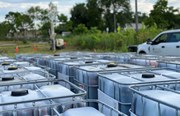5 Things You Need to Consider When NAPL Governs the Mass Present at Your Thermal Site
By: Steffen GriepkeThermal technologies have now been used for more than two decades to address highly contaminated source zones. In the beginning, thermal was typically utilized to address volatile organic compound (VOC) contaminations, such as contaminant mixtures dominated by chlorinated solvents and the lighter end of the hydrocarbons such as BTEX mixtures. However, that is no longer the case—thermal treatment is now frequently used to address sites contaminated with substances like tar and creosote, which are more effectively addressed with physical removal in the NAPL stage. In this blog post, we’ll cover five things you need to consider during the project planning and design stages, when NAPL governs the mass present at your site.
If you’d like a deeper dive, join us for next week’s webinar, Thermal Remediation of High Mass Hydrocarbon Sites: When NAPL Capture Governs the Mass Recovery. If you have questions, be sure to register as I’ll be answering them live during a Q&A at the end.
WHEN VOLATILIZATION IS THE MAIN REMOVAL MECHANISM
For VOCs, the governing removal mechanism is volatilization and mass removal in the vapor phase. Increasing the subsurface temperature from ambient to the boiling point of water effectively drives the majority of the VOCs to the vapor phase (>95%), where the mass now is easily captured by the vapor treatment system. A way of understanding if a chemical is susceptible for vaporization around the boiling point of water is to focus on the vapor pressure increase in the temperature range considered. For example, the vapor pressure of TCE and PCE increases a factor of 25 and 35 times respectively between ambient and boiling, while the corresponding vapor pressure increase for benzene is on the order of 25 times over the same temperature range.
WHEN PHYSICAL REMOVAL IS THE MAIN REMOVAL MECHANISM
In recent years, the focus for thermal projects has broadened to include higher boiling point contaminants like tar and creosote. For these chemicals and treatment to the boiling point of water, volatilization will not be the governing removal mechanism. For creosote, coal tar, PCBs and general oil-based source zones, the reduction in liquid viscosity with temperature can be several orders of magnitudes, and therefore NAPL mobility and direct removal play a major role in design and implementation of thermal remedies for these sites. An example from a treatability study we recently conducted showed a decrease in viscosity of a factor of more than 1,200 times between 24 °C and 90 °C (75 °F and 194 °F). That’s an amazing reduction of more than three orders of magnitude!
For these sites, physical mass removal in the NAPL phase is the governing mass removal mechanism, and volatilization is secondary. Thus, it is crucial for a successful thermal design for certain source zones to include provisions for proper NAPL removal and management – to both capture the chemical mass in the subsurface, and to properly handle the mobilized mass in the treatment system when brought to the surface. Recently we have seen sites where more than 80-98% of the mass came out in the NAPL phase.
WHAT TO CONSIDER DURING PLANNING AND DESIGN
Understanding the phase behavior of the NAPL and contaminants heavily impacts the thermal approach, and there are five major things you need to consider when planning your project strategy.
- Vapor treatment concept
If only a small fraction of the mass comes out in the vapor phase, a granular activated charcoal (GAC) based or steam regen GAC based system may be a better choice than a more robust thermal oxidation system. - Extraction strategy
When NAPL removal governs the mass removal, a well thought out multi-phase extraction strategy is required. Large viscosity changes with temperatures affect the design, types and selection of pumps as well as the liquid and piping manifold system. - Phase separation
Proper phase separation in the treatment system is required, to separate both LNAPL and DNAPL phases from the overall liquid stream. - Bio and emulsion management
Depending on the source of the NAPL, generation of substantial bio-mats and emulsions may heavily affect the ability to properly handle the extracted NAPL. - Storage and disposal
Substantial amounts of NAPL may be accumulated in the treatment system, and a proper storage system needs to be put in place. For example, at previous sites, we have had to manage more than a million pounds of generated NAPL. Additionally, a disposal strategy needs to be put in place, since some NAPL may contain chemicals like PCBs, PAHs and PFAS, that bring the NAPL into the typical hazardous waste category.
There are several key points to consider at high mass sites, where key chemical properties govern the mass removal. If you’d like to learn more about how to identify solutions for proper removal, register for next week’s webinar, Thermal Remediation of High Mass Hydrocarbon Sites: When NAPL Capture Governs the Mass Recovery.

